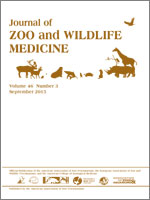A 9-yr-old castrated male dromedary camel (Camelus dromedarius) presented with lethargy and partial anorexia. A diagnostic examination revealed fever, and further workup revealed a neutrophilia, hyperfibrinogenemia, renal azotemia, and a rapid onset of a high Leptospira antibody titer during the acute clinical period (Grippotyphosa serovar). The camel responded clinically to antimicrobial treatment with ceftiofur crystalline free acid injections, but renal azotemia persisted, presumably secondary to chronic renal damage. Subsequent Leptospira polymerase chain reaction testing on urine samples obtained over the following 4 mo revealed no evidence of urinary shedding, so a persistent infection was unlikely. Although often mentioned as a potential cause of reproductive loss, well-documented case reports of clinical leptospirosis in camelids are very rare. In this case, native wildlife contamination of a small watering hole is suspected to have been the source of infection. In response to this experience, the camel and two conspecifics were prescribed a vaccination regimen using an inactivated pentavalent Leptospira vaccine licensed for cattle.
How to translate text using browser tools
1 September 2015
ACUTE CLINICAL LEPTOSPIROSIS (GRIPPOTYPHOSA SEROVAR) IN AN ADULT DROMEDARY CAMEL (CAMELUS DROMEDARIUS)
Zoltan S. Gyimesi,
Roy B. Burns,
Erdal Erol,
Steven R. Bolin
ACCESS THE FULL ARTICLE
Camel
Camelus dromedarius
ceftiofur crystalline free acid
Grippotyphosa
Leptospira
leptospirosis





